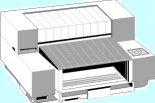PRINTERS
A printer is usually the first thing a new computer owner adds to the computer system - if one doesn't come with the system. Printers used to be slow, noisy and expensive; today they are fast, quiet and relatively inexpensive.
It wasn't very many years ago that the common home computer printer was a dot-matrix printer: nine (or maybe 24) pins in a moveable head that struck a ribbon to make marks on a paper. The printers were slow, prone to breakdowns and very noisy in operation. And they were black ink on white, fanfold, tractor-fed paper. The laser printer was also available but they usually cost well over $1,000 compared to the $250 to $600 cost of the dot-matrix printer. And they were also slow, pretty quiet but expensive to operate and used black ink on typewriter type paper.
Hewlett Packard changed all that with the introduction of the DeskJet printer line. They were inkjet printers that could compete with the dot-matrix printer in price, but were much quiter to operate, used the same paper that the laser printer used and were almost bomb-proof in operation.
Today the most common home computer printer is an inkjet printer. They can be bought at most major computer stores (or even large discount stores) for under $100. And they provide rapid, high-resolution color print and graphics with just a whisper of sound. Laser printers have also come down in price far enough to be affordable to the average consumer, but they still have the disadvantage of higher operating costs and color is still pretty expensive.
Hooking more than one printer to your computer is no big deal. You'll need more cables and a switch box - all of which are available at any large computer store or your local Radio Shack. A printer cable has two different types of connectors, both of them male. The end that plugs into the computer is sort of 'D' shaped with two rows of pins: a row of 13 above a row of 12. It's called a DB25 connector. The other end, the one that plugs into the printer, is also sort of 'D' shaped but it has a single solid tab running down the center of it. The tab has a number of small metal strips on either side of it (25 actually, 13 on one side, 12 on the other). This is called a centronics connector. If you buy a switch box (usually called an A-B Box) with female DB25 connectors for the input and output, you'll need to buy one cable with a male DB25 connector at each end that will run from the computer to the A-B box. Then you'll need two regular printer cables to run from the A-B box to the printers. That's it. Now you have one cheap printer to do normal work with and one expensive printer that you use for important stuff. Or whatever. Three printers on the same computer is just as easy - just buy an A-B-C box and an extra printer cable. Then you could use your old dot-matrix printer for draft work, your color inkjet for home and school and a laser printer for your business stuff. I've seen these switch boxes with as many as 6 positions on them, and you could daisy-chain them together, so I guess the sky's the limit as far as how many printers you could connect to one computer. Some of the switch boxes are electronic - they will switch automatically to the printer you select from your computer.
Some of the newest inkjet (and laser) printers are being designed with the home office in mind: they are an all-in-one printer, copier, scanner and fax machine. It pays to shop around if you are in the market for a new (or replacement) printer - prices can vary as much as 50% on the same machine in different stores. Some stores will offer a selected printer at cost just to get you in the door. And you always need to check for rebates - that can sometimes save you even more money.
Suggested Reading: How To...,- Lesson 15, Printing
If you got here from somewhere other than the table of contents, use the Back Button at the upper left hand side of your screen to go back. It looks like this:
Click here to return to table of contents.
